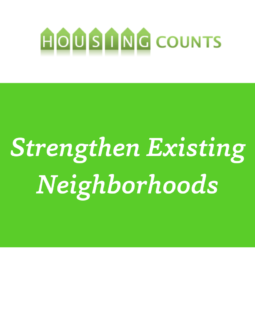Strengthen and Promote Existing Neighborhoods
Neighborhoods are the fabric of a community, a part of the threads that tie both geographic and social systems together. When one neighborhood is in decline, the whole community can be at risk. Neighborhoods, whether official or perceived play a critical role in the success of local housing and infrastructure policy. Strengthening and promoting existing neighborhoods can stabilize the housing stock and contribute towards community ties. These ties produce a stronger community that can effectively react to problems such as crime, litter or deterioration. Dealing with these threats in a proactive and forceful manner can ensure the vitality and property values of a community.
Where are neighborhood preservation policies most applicable?
Neighborhood preservation and maintenance plans can help to protect the health, safety and welfare of the people who live within the community. Strong public policies and strategies help create a framework for addressing deterioration issues before they become a widespread problem within a community. The guiding principles of any public neighborhood preservation strategy should be interventions that focus on critical issues. A resolution of these critical issues can restore neighborhood confidence, increase community pride, protect housing values, and strengthen civic involvement. There are many local tools and strategies available to prevent neighborhood deterioration and promote neighborhood pride. Below is a summary of the most common tools and strategies within the Twin Cities metropolitan area.
Neighborhood Promotion
Many cities support the organization of neighborhoods by offering staff support and financial assistance to neighborhood associations. Having a neighborhood with residents who feel connected has positive impacts on property aesthetics, public safety issues and overall quality of life. Neighborhood groups can rally residents together to solve a problem or voice an opinion on a special issue. They can also hold neighborhood get-togethers, organize park clean-ups, or share services (trading home maintenance for child care, for example). Many neighborhoods publish newsletters listing upcoming events and neighborhood news. A suburban city example includes the City of St. Louis Park with 35 neighborhood associations supported by a city community liaison. Neighborhoods within St. Louis Park can apply for up to $2,000, with a $600 maximum for any individual neighborhood event. There is a grant review committee to determine who gets the money. Money can be used for events or newsletters. In addition, the city hosts a neighborhood forum annually where anyone from the neighborhood association can attend. The neighborhood forum provides ongoing communication with neighborhood leaders about city activities, policies and development issues. Each organization must have at least one member attend the annual meetings in order to be eligible for city grants. The City also maintains a web site that provides information on the neighborhoods.
City Interdepartmental Approach
Addressing neighborhood issues becomes an interdepartmental issue for cities. Interdepartmental approaches help to provide more consistencies and efficiencies in solving home maintenance, crime and neighborhood social issues. The City of Brooklyn Park began a new program to solve neighborhood issues through a more coordinated interdepartmental approach that involves residents called the Neighborhood Action Program (NAP). The goal of NAP is to reduce crime and improve the livability of challenged and distressed neighborhoods. This is being accomplished through the creation of a problem-solving collaborative between city departments. A number of new crime-fighting and quality of life improvement strategies are being developed and implemented:
- Enhanced law enforcement presence focusing on repeat criminal offenders that have negatively affected the safety of a neighborhood.
- Increased property maintenance inspections and enforcement of codes in focus areas to improve the quality of life in neighborhoods.
- Increased information exchanges between Police, Code Enforcement and Public Health, Rental Housing Inspections, Economic Development and Recreation and Parks with neighborhood residents, property owners, home owner associations and rental management companies. The goal is to actively involve residents in problem-solving efforts.
Housing Maintenance Codes
Local housing maintenance codes help to address the exterior maintenance of housing and neighborhood nuisance issues such as overgrown lawns, junk vehicles, peeling paint and rodent infestation. Many housing maintenance codes also address inspections on rental housing through a rental housing ordinance.
Point of Sale
Point-of-Sale Ordinances require that home maintenance violations are corrected prior to the sale of a home. The program is aimed at protecting the community’s overall housing stock and avoiding unsafe conditions and major deterioration. The program requires that a property maintenance certificate be presented to the buyer and title company when the property transfer occurs at closing. If code violations are found, work orders are issued for the needed repairs. In most cases, corrections must meet the code requirements that were in place when the building was constructed. If a portion of the home was remodeled, the remodeled section must comply with the building code that was in effect when the remodeling occurred. This program typically is facilitated by local city staff with the city inspector. However, in some cases, the inspections can be outsourced through a contract with the city.
Truth in Housing
Truth-in-Housing Ordinances require that home inspections are conducted and that a disclosure report is prepared prior to the sale of a home. The report is an overview of the building components and fixtures of the home based upon the city housing code. The purpose is to inform prospective buyers of the observed condition of the dwelling unit at the time of the evaluation. The disclosure report is intended to provide basic information to the home buyer and the seller prior to the time of sale. Mortgage companies may require that some of the conditions be improved prior to sale. In addition, there are some items that must be fixed such as those of an imminent health and safety concern. The ordinance helps to resolve existing home maintenance issues when homes are resold. In many cases, the program is facilitated by private inspectors, approved by the City, and through real estate agents. City staff has a minor role in the process.
